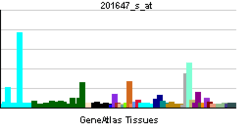SCARB2
| Scavenger receptor class B, member 2 | |||||||||||||
|---|---|---|---|---|---|---|---|---|---|---|---|---|---|
 Structure of the lysosomal domain of limp-2. PDB entry 4f7b | |||||||||||||
| |||||||||||||
| Identifiers | |||||||||||||
| Symbols | SCARB2 ; AMRF; CD36L2; EPM4; HLGP85; LGP85; LIMP-2; LIMPII; SR-BII | ||||||||||||
| External IDs | OMIM: 602257 MGI: 1196458 HomoloGene: 48353 GeneCards: SCARB2 Gene | ||||||||||||
| |||||||||||||
| RNA expression pattern | |||||||||||||
 | |||||||||||||
 | |||||||||||||
| More reference expression data | |||||||||||||
| Orthologs | |||||||||||||
| Species | Human | Mouse | |||||||||||
| Entrez | 950 | 12492 | |||||||||||
| Ensembl | ENSG00000138760 | ENSMUSG00000029426 | |||||||||||
| UniProt | Q14108 | O35114 | |||||||||||
| RefSeq (mRNA) | NM_001204255 | NM_007644 | |||||||||||
| RefSeq (protein) | NP_001191184 | NP_031670 | |||||||||||
| Location (UCSC) | Chr 4: 77.08 – 77.14 Mb | Chr 5: 92.44 – 92.51 Mb | |||||||||||
| PubMed search | |||||||||||||
Lysosome membrane protein 2 is a protein that in humans is encoded by the SCARB2 gene.[1][2]
The protein encoded by this gene is a type III glycoprotein that is located primarily in limiting membranes of lysosomes and endosomes. Studies of the similar protein in mice and rat suggested that this protein may participate in membrane transportation and the reorganization of endosomal/lysosomal compartment. Deficiency of the similar protein in mice was reported to impair cell membrane transport processes and cause pelvic junction obstruction, deafness, and peripheral neuropathy.[2]
Clinical significance
SCARB2 is a receptor for two viruses that cause hand, foot, and mouth disease in children, Enterovirus 71 and Coxsackievirus A16.[3]
References
- ↑ Fujita H, Takata Y, Kono A, Tanaka Y, Takahashi T, Himeno M, Kato K (Jun 1992). "Isolation and sequencing of a cDNA clone encoding the 85 kDa human lysosomal sialoglycoprotein (hLGP85) in human metastatic pancreas islet tumor cells". Biochem Biophys Res Commun 184 (2): 604–11. doi:10.1016/0006-291X(92)90632-U. PMID 1374238.
- ↑ 2.0 2.1 "Entrez Gene: SCARB2 scavenger receptor class B, member 2".
- ↑ Yamayoshi S, Yamashita Y, Li J, Hanagata N, Minowa T, Takemura T, Koike S (July 2009). "Scavenger receptor B2 is a cellular receptor for enterovirus 71". Nat. Med. 15 (7): 798–801. doi:10.1038/nm.1992. PMID 19543282.
Further reading
- Eskelinen EL, Tanaka Y, Saftig P (2003). "At the acidic edge: emerging functions for lysosomal membrane proteins.". Trends Cell Biol. 13 (3): 137–45. doi:10.1016/S0962-8924(03)00005-9. PMID 12628346.
- Sandoval IV, Arredondo JJ, Alcalde J et al. (1994). "The residues Leu(Ile)475-Ile(Leu, Val, Ala)476, contained in the extended carboxyl cytoplasmic tail, are critical for targeting of the resident lysosomal membrane protein LIMP II to lysosomes.". J. Biol. Chem. 269 (9): 6622–31. PMID 7509809.
- Calvo D, Dopazo J, Vega MA (1995). "The CD36, CLA-1 (CD36L1), and LIMPII (CD36L2) gene family: cellular distribution, chromosomal location, and genetic evolution.". Genomics 25 (1): 100–6. doi:10.1016/0888-7543(95)80114-2. PMID 7539776.
- Crombie R, Silverstein R (1998). "Lysosomal integral membrane protein II binds thrombospondin-1. Structure-function homology with the cell adhesion molecule CD36 defines a conserved recognition motif.". J. Biol. Chem. 273 (9): 4855–63. doi:10.1074/jbc.273.9.4855. PMID 9478926.
- Harris RA, Yang A, Stein RC et al. (2002). "Cluster analysis of an extensive human breast cancer cell line protein expression map database.". Proteomics 2 (2): 212–23. doi:10.1002/1615-9861(200202)2:2<212::AID-PROT212>3.0.CO;2-H. PMID 11840567.
- Wistow G, Bernstein SL, Wyatt MK et al. (2002). "Expressed sequence tag analysis of human RPE/choroid for the NEIBank Project: over 6000 non-redundant transcripts, novel genes and splice variants.". Mol. Vis. 8: 205–20. PMID 12107410.
- Kuronita T, Eskelinen EL, Fujita H et al. (2003). "A role for the lysosomal membrane protein LGP85 in the biogenesis and maintenance of endosomal and lysosomal morphology.". J. Cell. Sci. 115 (Pt 21): 4117–31. doi:10.1242/jcs.00075. PMID 12356916.
- Rodionov DG, Höning S, Silye A et al. (2003). "Structural requirements for interactions between leucine-sorting signals and clathrin-associated adaptor protein complex AP3.". J. Biol. Chem. 277 (49): 47436–43. doi:10.1074/jbc.M207149200. PMID 12370188.
- Strausberg RL, Feingold EA, Grouse LH et al. (2003). "Generation and initial analysis of more than 15,000 full-length human and mouse cDNA sequences.". Proc. Natl. Acad. Sci. U.S.A. 99 (26): 16899–903. doi:10.1073/pnas.242603899. PMC 139241. PMID 12477932.
- Gamp AC, Tanaka Y, Lüllmann-Rauch R et al. (2003). "LIMP-2/LGP85 deficiency causes ureteric pelvic junction obstruction, deafness and peripheral neuropathy in mice.". Hum. Mol. Genet. 12 (6): 631–46. doi:10.1093/hmg/12.6.631. PMID 12620969.
- Zhang H, Li XJ, Martin DB, Aebersold R (2003). "Identification and quantification of N-linked glycoproteins using hydrazide chemistry, stable isotope labeling and mass spectrometry.". Nat. Biotechnol. 21 (6): 660–6. doi:10.1038/nbt827. PMID 12754519.
- Mulcahy JV, Riddell DR, Owen JS (2004). "Human scavenger receptor class B type II (SR-BII) and cellular cholesterol efflux.". Biochem. J. 377 (Pt 3): 741–7. doi:10.1042/BJ20030307. PMC 1223905. PMID 14570588.
- Ota T, Suzuki Y, Nishikawa T et al. (2004). "Complete sequencing and characterization of 21,243 full-length human cDNAs.". Nat. Genet. 36 (1): 40–5. doi:10.1038/ng1285. PMID 14702039.
- Gerhard DS, Wagner L, Feingold EA et al. (2004). "The status, quality, and expansion of the NIH full-length cDNA project: the Mammalian Gene Collection (MGC).". Genome Res. 14 (10B): 2121–7. doi:10.1101/gr.2596504. PMC 528928. PMID 15489334.
- Eckhardt ER, Cai L, Shetty S et al. (2006). "High density lipoprotein endocytosis by scavenger receptor SR-BII is clathrin-dependent and requires a carboxyl-terminal dileucine motif.". J. Biol. Chem. 281 (7): 4348–53. doi:10.1074/jbc.M513154200. PMID 16368683.
- Gupta SN, Kloster MM, Rodionov DG, Bakke O (2007). "Re-routing of the invariant chain to the direct sorting pathway by introduction of an AP3-binding motif from LIMP II.". Eur. J. Cell Biol. 85 (6): 457–67. doi:10.1016/j.ejcb.2006.02.001. PMID 16542748.
- Tserentsoodol N, Gordiyenko NV, Pascual I et al. (2006). "Intraretinal lipid transport is dependent on high density lipoprotein-like particles and class B scavenger receptors.". Mol. Vis. 12: 1319–33. PMID 17110915.
- Grove J, Huby T, Stamataki Z et al. (2007). "Scavenger receptor BI and BII expression levels modulate hepatitis C virus infectivity.". J. Virol. 81 (7): 3162–9. doi:10.1128/JVI.02356-06. PMC 1866051. PMID 17215280.